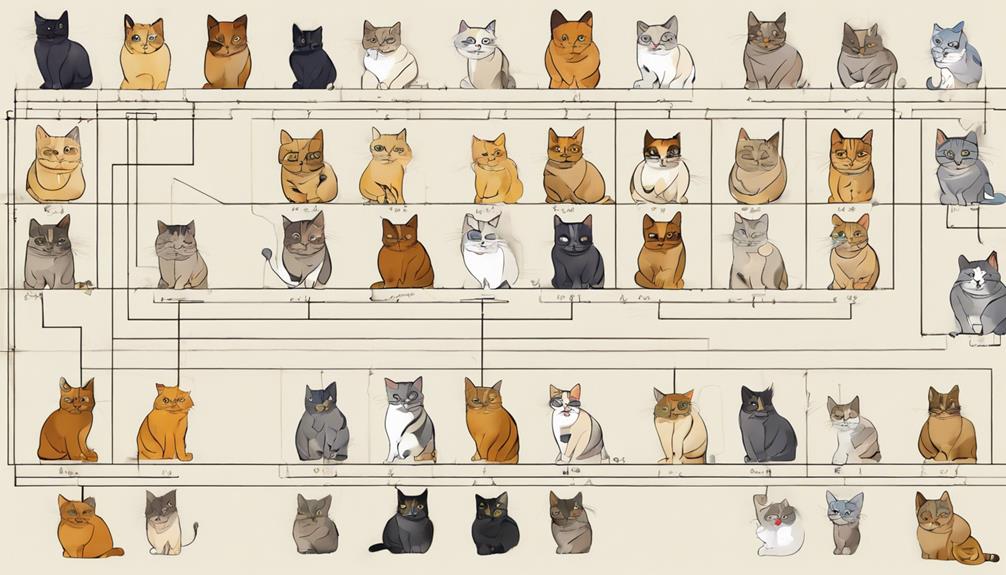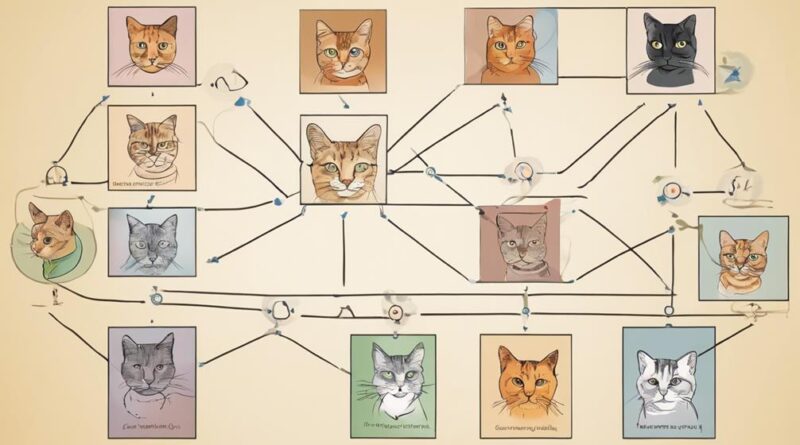What Measures Prevent Inbreeding in Cat Breeding?
When it comes to navigating the complex world of cat breeding, think of preventing inbreeding as a delicate dance of genetic harmony. Various measures, such as genetic testing and outcrossing strategies, play crucial roles in ensuring the health and vitality of future feline generations.
But what about the intricate web of pedigree analysis and the strategic maintenance of genetic diversity? Stay tuned to discover how these vital practices, along with other key techniques, work together to safeguard the well-being of our feline companions.
Genetic Testing
When considering preventing inbreeding in cat breeding, genetic testing plays a crucial role in identifying potential risks. DNA profiling is a fundamental tool used in genetic testing to examine the unique genetic makeup of each cat. Through DNA profiling, breeders can detect genetic variations and ensure that mating pairs aren't closely related, thus reducing the risk of inbreeding.
Mutation detection is another key aspect of genetic testing. By screening for mutations that may lead to hereditary diseases or deformities, breeders can make informed decisions about which cats to breed. Identifying and avoiding carriers of harmful mutations is essential in maintaining the health and genetic diversity of cat populations.
Genetic counseling is a valuable resource for cat breeders. Genetic counselors can provide insights based on genetic test results, offering guidance on breeding practices to minimize the risk of inbreeding. Additionally, they can help breeders understand the implications of certain genetic traits and diseases, enabling them to make responsible breeding choices.
Health screening is an integral part of genetic testing in cat breeding. By conducting thorough health screenings, breeders can identify potential health issues that may be passed on to offspring. Screening for common feline diseases and health conditions allows breeders to select healthy cats for breeding, promoting the overall well-being of future generations.
Outcrossing Strategies
Implementing strategic outcrossing is essential in diversifying the gene pool and minimizing the risks of inbreeding in cat breeding practices. When considering outcrossing strategies, there are several key factors to keep in mind:
- Genetic Selection: Prioritize genetic diversity when selecting breeding pairs. Look for cats that aren't closely related to each other to introduce new genetic material into the breeding lines.
- Health Considerations: Ensure that the cats chosen for outcrossing are healthy and free from any hereditary diseases. This helps maintain the overall health and well-being of the offspring.
- Temperament Matching: Besides genetics, consider the temperament of the cats being bred. Matching cats with complementary personalities can lead to well-adjusted and sociable kittens.
- Long-Term Planning: Think about the impact of outcrossing on future generations. Develop a breeding plan that includes periodic outcrossing to continuously refresh the gene pool.
Pedigree Analysis
To ensure the genetic health and diversity of your cat breeding program, conducting a thorough pedigree analysis is crucial. By delving into the ancestral lineage of your cats, you can gain valuable insights into their genetic backgrounds. Pedigree analysis involves studying the family tree of each cat to identify potential genetic issues, inbreeding risks, and opportunities to enhance genetic diversity within your breeding program.
Examining the pedigree of your cats allows you to trace back several generations and pinpoint any common ancestors or genetic markers that may pose a risk to the overall health of the breeding stock. By identifying these potential concerns early on, you can make informed decisions to avoid inbreeding and maintain the well-being of future litters.
Through pedigree analysis, you can also uncover hidden genetic strengths within your breeding lines. By understanding the strengths and weaknesses of each cat's genetic makeup, you can strategically pair cats to capitalize on their diverse genetic backgrounds, ultimately promoting the overall health and vigor of your breeding program.
Maintaining Genetic Diversity
Ensuring the longevity of your cat breeding program hinges on actively preserving and nurturing genetic diversity within your feline population. Maintaining genetic diversity is crucial to prevent inbreeding and maintain the overall health and vitality of your cats.
Here are some key strategies to help you in this important endeavor:
- Utilize DNA sequencing techniques: Embracing advanced DNA sequencing methods can provide valuable insights into the genetic makeup of your cats, helping you make informed breeding decisions to maintain diversity.
- Prioritize biodiversity conservation: Actively work to conserve and protect the existing genetic variation within your cat population to prevent the loss of valuable traits and characteristics.
- Be mindful of genetic drift: Genetic drift, the random fluctuation of gene frequencies, can inadvertently reduce genetic diversity. Monitor and manage this phenomenon to safeguard the gene pool of your cats.
- Understand population dynamics: Familiarize yourself with population dynamics to effectively manage breeding practices and ensure the long-term viability of your feline population.
Breeding Program Management
How can you effectively oversee the management of your cat breeding program to ensure its success and sustainability?
To start, implementing regular health screenings for all breeding cats is crucial. These screenings help identify any potential genetic issues that could be passed on to offspring, allowing you to make informed decisions about which cats to breed. By prioritizing the health of your breeding cats, you can help maintain the overall well-being of future generations.
Furthermore, establishing breeding restrictions is essential in managing your program effectively. Setting clear guidelines on which cats are eligible for breeding helps prevent inbreeding and promotes genetic diversity within your breeding pool. By limiting the number of litters each cat can have or restricting breeding between closely related cats, you can reduce the risk of hereditary health issues and maintain a healthy population of cats.
Consistent monitoring and documentation are also vital components of successful breeding program management. Keeping detailed records of health screenings, breeding pairings, and offspring lineage can help you track the genetic history of your cats and make informed breeding decisions. Regularly reviewing and updating your breeding restrictions based on this information is key to adapting and improving your program over time.
Selective Breeding Practices
Implementing selective breeding practices is crucial to maintaining genetic diversity and preventing inbreeding within your cat breeding program. To ensure the health and vitality of your feline population, consider the following key points:
- Breeding Standards: Establish clear breeding standards based on traits, temperament, and conformation to guide your selection process. By adhering to these standards, you can avoid the pitfalls of inbreeding and maintain a robust gene pool.
- Health Screening: Prioritize health screening for all breeding cats to identify potential genetic disorders or hereditary conditions. Regular screenings can help you make informed breeding decisions and reduce the risk of passing on harmful genes to future generations.
- Genetic Diversity: Strive to introduce new genetic lines into your breeding program to enhance genetic diversity. By outcrossing with unrelated cats, you can broaden the gene pool and minimize the chances of inbreeding.
- Breed Preservation: While focusing on genetic diversity, also aim to preserve the unique characteristics and heritage of the breed. Balancing preservation with outcrossing is key to maintaining breed standards and ensuring the long-term health of your cats.
Inbreeding Coefficient Monitoring

To monitor the inbreeding coefficient effectively in your cat breeding program, utilize specialized tools and genetic analysis techniques. Keeping a close eye on the inbreeding risk is crucial in maintaining a healthy cat population. By understanding the population size, you can better assess the potential for inbreeding within your breeding group.
Genetic diseases are a significant concern in cat breeding. Monitoring the allele frequency can help you identify carriers of certain genetic diseases within your population. By tracking the frequency of these alleles, you can make informed decisions to avoid breeding cats that may pass on harmful genetic traits to their offspring.
Utilizing advanced tools such as software designed for calculating inbreeding coefficients can streamline this process. These tools can provide you with accurate data on the level of inbreeding in your breeding program, allowing you to make informed decisions about which cats to breed to minimize the risk of inbreeding.
Collaborative Breeding Efforts
To enhance the genetic diversity and health of your cat breeding program, consider engaging in collaborative breeding efforts with other responsible breeders in the community. Collaborative partnerships can offer numerous benefits that help prevent inbreeding and promote the overall well-being of the breed.
Here's why you should consider collaborating with other breeders:
- Increased Genetic Diversity: By working with other breeders, you can introduce new bloodlines into your breeding program, reducing the risk of inbreeding and its associated health issues.
- Knowledge Sharing: Collaborating with experienced breeders allows for the exchange of valuable knowledge and insights, helping you make more informed breeding decisions.
- Shared Resources: Pooling resources such as stud cats, genetic testing facilities, and breeding space can help reduce costs and increase efficiency in your breeding program.
- Support System: Building collaborative partnerships creates a support system where breeders can rely on each other for advice, guidance, and assistance when facing challenges in their breeding endeavors.
Frequently Asked Questions
Can Inbreeding Be Completely Eliminated in Cat Breeding Programs?
In cat breeding programs, completely eliminating inbreeding is challenging due to limited genetic diversity. Breeding practices aim to minimize inbreeding risks by carefully selecting mating pairs.
Population management, such as outcrossing with unrelated cats, can help maintain genetic variation. While complete elimination may not be possible, proactive measures can mitigate the effects of inbreeding and promote healthier cat populations.
Are There Any Ethical Concerns Related to Inbreeding in Cat Breeding?
When it comes to ethical considerations in cat breeding, it's crucial to prioritize genetic diversity.
Inbreeding can lead to various health issues and reduce the overall vitality of the feline population. By introducing new genetic lines and carefully selecting breeding pairs, you can help prevent these problems and promote a healthier cat population.
How Do Breeders Ensure the Health and Well-Being of Cats Born From Inbred Lines?
To ensure the health and well-being of cats from inbred lines, breeders use genetic testing and proper breeding practices. By conducting genetic tests, breeders can identify potential health issues and make informed decisions.
They also employ responsible breeding practices like outcrossing with unrelated cats to introduce genetic diversity. These measures help reduce the risk of genetic disorders and promote the overall health of the cats in their care.
What Impact Does Inbreeding Have on the Overall Population of a Specific Cat Breed?
Inbreeding impacts the overall population of a specific cat breed by reducing genetic diversity. This can lead to health issues and decrease population dynamics. Breeders must carefully manage mating pairs to avoid inbreeding depression and maintain a healthy gene pool.
Genetic diversity is vital for the long-term sustainability and well-being of the breed. Monitoring and controlling inbreeding levels are essential to ensure the population's resilience and vitality.
Are There Any Legal Regulations or Guidelines in Place to Prevent Excessive Inbreeding in Cat Breeding?
When it comes to cat breeding, genetic testing and proper breeding practices are crucial. By implementing these measures, you can help prevent excessive inbreeding and maintain the health and diversity of the feline population.
Regulations and guidelines may vary, but staying informed and responsible in your breeding decisions is key to preventing issues related to inbreeding. Stay proactive and prioritize the well-being of the cats in your care.
Conclusion
Overall, preventing inbreeding in cat breeding requires a combination of measures such as genetic testing, outcrossing strategies, pedigree analysis, and maintaining genetic diversity.
By implementing selective breeding practices, monitoring inbreeding coefficients, and collaborating with other breeders, you can ensure the health and longevity of future feline generations.
Remember, responsible breeding practices are essential to preserving the well-being of our beloved feline companions.
